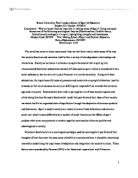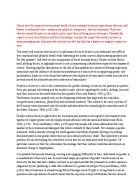Relating this to a sporting context we can assume that the second class of ‘Imperatives of compatibility’ show us how athletes of a certain culture behave under certain limits. Boxing in many ways is an example of this as the most successful boxers such as Muhammad Ali and Mike Tyson came from rather lower class, black African American backgrounds. These backgrounds or as Parsons called them ‘limits’ where generally rough and violent due to the nature of the society they lived in. Boxing thus, was and in many ways still is, a sign of opportunity that appeals too many of these people’s as their behavioural class and sport are tied together in accordance to their social limits, thus providing them with the hope of a better future. Functionalists due to this share a very positive stance towards sport according to the benefits it provides to society, as they believe it helps to maintain order, provide opportunity and increase participation.
Talcott Parsons and with Emile Durkheim were the two most influential figures in the study of functional theory. Whilst Durkheim was seen by some to be the father figure of not only functionalism but sociology as a whole, Parsons during the 1950’s placed the theory in extremely high regard. It in fact gained so much of the publics support that functionalism and sociology were considered to be one and the same. Soon however, criticisms of their theories begun to surface and functionalism rapidly came under increasing pressure. Parsons and other functionalists were criticised for not being able to explain social change but more significantly as Rex (1961) noted, ‘‘Change arising within the system itself rather then in the enviornment’’ (p.445). In a more direct example, in the late 1950’s functionalists were not able to explain the new social movements in North America and this is where conflict approaches started to surface. Critics of the theory also had one main line of argument: if everything in society had a function and the needs and goals were being met, then functionalists would consider society complete. That then raised the question: why would subsystems or even the whole of society be subject to change, if everything was successfully functioning? Social change is perhaps the solution, as we see teams achieving their goals at the most elite level of performance, but still making adjustments inside their organisation to adapt to this social change.
From that period on functionalism was nearly completely discredited and since then a new breed of functionalists have tried to re-ignite the spark that attracted so much of the public’s attention, but with limited success. However this does not mean that the theory should be discarded as a whole as some aspects of it teach us some very important lessons within the way society works. For example, Parsons (1951) was a strong believer in the importance of an individual in society and, ‘‘Where there is social interaction, signs and symbols acquire common meanings and serve as a media of communication between actors’’ (p.5). Parsons was adamant that this understanding of symbols needed to be accepted and agreed upon by all, as this was what he considered essential to the interaction between all systems of society. Applying this to a sporting context we can see that athletes have a collection of signs and symbols they use to compete with, such as a set of behaviours or rules and these are known as ‘need-dispositions’ (Parsons, 1951, p.7). These ‘need-dispositions’ are the requirements of ‘actors’ as they require internalisation so that people can act in a correct manor in accordance with society. As an example, once an athlete internalises the rules and behaviours of a game, only then can they start competing successfully as they are acting in a manner which has been pre determined by society.
Functionalists have a strong view of evolutionary change and as it slowly takes place, they believe that the various systems of society such as sport consequently try to adapt to these new changes. Durkheim (1982) commented that, ‘‘Great changes have taken place in industrial techniques since a century ago; therefore changes of equal importance in social organisation must result from them’’ (p.170). Political and technical change over the past years for example have increased participation in sport and modified the way sport is governed and played. Societies according to Parsons (1951) are subject to differences, as well as change and this is where other important societal requirements such as, ‘value-orientation’ (p.12) are important to understand and appreciate as contrasts of society. It is expected that different societies have different values and what one society might value, another might not.
Equilibrium in society is a similarly important component in a changing society, as the balance inside a society will influence the stability in sport as well as other subsystems. This equilibrium of subsystems describes how society outside the sporting world influence the way that sport is played and governed in different societies with different norms. An example of this would be in Saudi Arabia where in society even today, women’s rights are very limited and thus in sport it is still considered illegal for women to participate professionally. Therefore, we can conclude that sport reflects the values and norms of society and that contrasting societies have significant differences in all parts of their system.
Functionalism, although a very important part of mid 20th century society had its opponents in the way of different types of sociological theories, which included different views and opinions of the way society was managed. One such theory was the Marxist ideology that believed the functionalist view in capitalist societies only benefited a small part of society which generally consisted of the middle to upper class due to their economical advantage. This was and in many ways still is supported by events such as motor sport as the majority of drivers come from wealthier backgrounds due to the huge expenses the driver incurs throughout the learning process. On the other hand, Marxism in itself had a strong connection to functionalism and this is mainly directed at the working class as the state functions for their economical interest. Karl Marx, the founder of Marxism to a certain extent acknowledged this link to functionalism:
The necessity , within a large-scale productive unit, of having a system of rules to coordinate individual lines of action; and these rules must necessarily be formulated and enforced by a distinctive part of the unit, which to that extent acts on behalf of the whole (Poggi, 1972, p.109). Functionalists however tried to produce a theory that would oppose any of the influences induced by other theoretical structures such as Marxism, but also Communism and Socialism. This is perhaps where some of the links between theories occurred as it was difficult to produce a theory based purely on its own ideologies.
Functional theorists have constructed their own theory which has tried to bring together an approach which includes the importance of social interaction and the requirements of people to fulfil their duties. In many ways functionalism and sport go hand in hand with many of these proposed functionalist theories in making sense of sport as sport is a societal construction and is part of what Parsons (1951) called, ‘‘Essentially a network of interactive relationships’’ (p.51). Therefore social theory and sport have very significant links and these links are what hold the key to the future and more importantly societal change, a change that is consistently occurring and affecting the world we live in.
References
Durkheim, E., Lukes, S., & Halls, W.D. (1982). The rule of sociological method and selected texts on sociology and its method. London: The Macmillan Press Ltd.
Parsons, T. (1951). The social system. London: Routledge & Kegan Paul Ltd.
Poggi, G. (1972). Images of Society, California, Stanford University Press
Worsley, P., & Rex, J. (1961) Modern Sociology - Key Problems in Sociological Theory, Middlesex, Penguin Books Inc.
Bibliography
Durkheim, E., Lukes, S., & Halls, W.D. (1982). The rule of sociological method and selected texts on sociology and its method. London: The Macmillan Press Ltd.
Hadden, R.W., Wallace, R.A., & Wolf, A. (1999). Introduction to Social Theory. Retrieved November 22, 2007, from the University of Regina, Web site: http://uregina.ca/~gingrich/n2f99.htm
Livessey, C. (no date). Sociology Central - Theory and Methods, Retrieved November 22, 2007, from Sociology Central, Web site: http://www.sociology.org.uk/cload.htm
No author stated. (2007).Talcott Parsons - Wikipedia. Retrieved November 15, 2007, from Wikimedia Foundation Inc., Web site: http://en.wikipedia.org/wiki/Talcott_Parsons
Parsons, T. (1951). The social system. London: Routledge & Kegan Paul Ltd.
Poggi, G. (1972). Images of Society, California, Stanford University Press.
Roberts, A. (No date). Social Science History Biographical Literature Reviews. Retrieved November 17, 2007, from Middlesex University, Web site: http://www.mdx.ac.uk/www/study/sshbilit.htm#Parsons
Worsley, P., & Rex, J. (1961). Modern Sociology - Key Problems in Sociological Theory, Middlesex, Penguin Books Inc.







